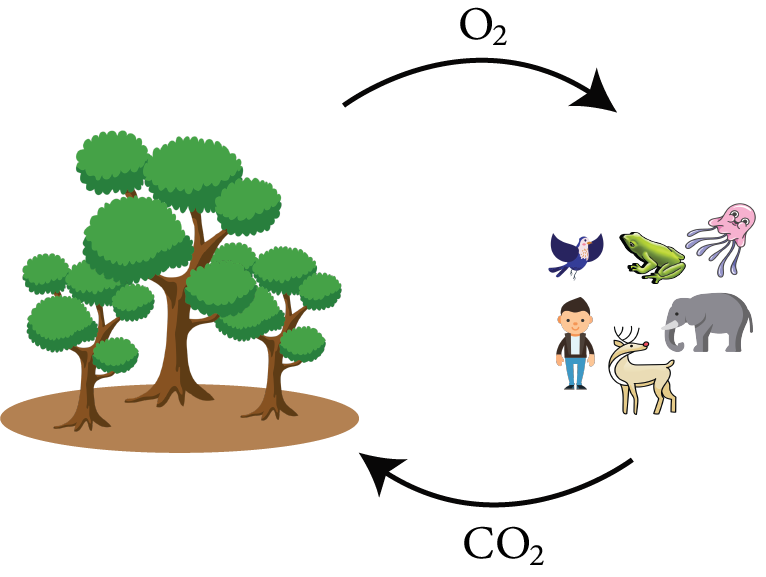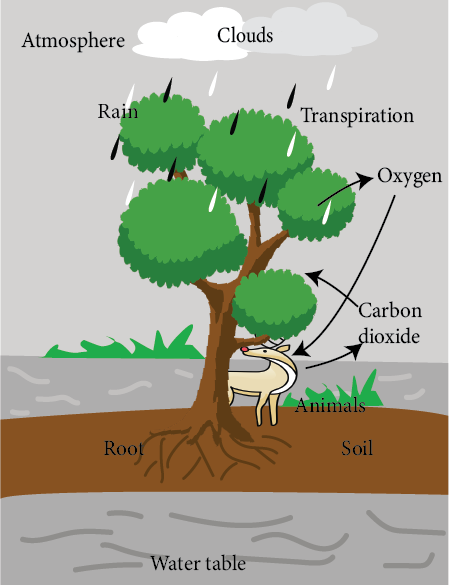NCERT Solutions for Class 7 Science Forest Our Lifeline Question Answers - FREE PDF Download



























FAQs on NCERT Solutions for Class 7 Science Chapter 12 Forest Our Lifeline
1. What are the Roles of Plants and Animals in the Regeneration of Forests from class 7 science chapter 12?
Forests include different species of plants and animals and these plants and animals are held responsible for the growth and regeneration of forest covers. The animals and microorganisms contribute the utmost in the process of forest regrowth in the following ways:
The micro-organisms in the soil help in converting the dead remains of plants and other animals into humus which contributes to the soil fertility and helps in the growth of new plants.
Animals living in the forest help in seed dispersal of some plants which helps in the growth of new plants and expands the forest cover.
2. Explain How Forests Help in Maintaining the Oxygen Level in the Environment from class 7 science forest our lifeline question answers.
The plants are generally considered as a natural air purifier. The plants require carbon dioxide to prepare their food. So, they absorb the carbon dioxide released from humans and animals, and in return, plants provide oxygen as an end product of photosynthesis. This oxygen is released into the atmosphere, thereby maintaining a balance of oxygen and carbon dioxide in the atmosphere. The depletion of forest covers from the earth can be harmful as it can reduce the level of oxygen in the atmosphere.
3. What are class 7 science chapter 12 question answers about?
Chapter 12 of the Class 7 Science Forest: Our Lifeline is concerned with the state of our country's forest areas. It emphasises the significance of trees in our lives while simultaneously depicting the negative consequences of forest depletion on the ecosystem and human lives. This chapter is based on a field trip to a forest, where students learn about the many flora and creatures that live in the woods. Forests contribute to the preservation of natural equilibrium. Forests serve a critical part in human life, and this chapter, Forest: Our Lifeline, emphasises their significance.
4. Why are forests also known as our lifeline as discussed in the forest our lifeline class 7 questions with answers?
Forests aid in the preservation of natural equilibrium. They play a crucial part in people's lives, and this chapter emphasises the value of forests. Forests are home to a variety of species that play a vital part in maintaining the forest's food chain. Forests include a variety of species, including medicinal herbs, wood, and lumber. Forest products aid in the maintenance of human living standards. Many flora and animal species rely on forests for their survival, and NCERT Class 7 Science Chapter 12 discusses the importance of these forest coverings.
5. What are decomposers from class 7 science forest our lifeline?
Decomposers are the microorganisms that transform dead plants and animals into humus. In the forest, these microorganisms perform an essential function. Paheli soon removed some dead leaves and noticed a layer of humus on the forest floor beneath them. The nutrients from dead plants and animals have been released into the soil thanks to the presence of humus. These nutrients are then absorbed once more by the roots of live plants.
6. Why is there no waste in a forest according to forest our lifeline?
Everything is reused and recycled in forests. Decomposers are necessary for trash breakdown (dead plants or animals). Decomposed garbage can be used as a fertiliser to aid in the growth of trees. As a result, the forest is devoid of waste. Decomposers, as the name indicates, decompose things for nourishment and nutrition. In general, decomposers are microorganisms that break down dead plants and animals in order to provide and absorb nutrients. Microorganisms include fungi and bacteria, for example.
7. What are the benefits of NCERT Solutions for class 7th science chapter 12 question answers?
NCERT answers for Class 7 Science Chapter 12 has solutions to all the questions of NCERT textbook. It also includes several solved examples to help students finish the chapter. This answer instills confidence in the pupils and helps them comprehend the chapter better. NCERT Solutions for Class 7 Science Chapter 12 gives a comprehensive review of the chapter as well as a simple explanation. It contains answers to all of the questions posed in the exercise, as well as some example questions that may appear in examinations. These answers have been produced by some of India's most experienced Science instructors. And these answers are available on Vedantu’s official website (vedantu.com) and mobile app free of cost.
8. What key topics are covered in the forest our lifeline class 7?
The importance of forests for purifying air and providing oxygen.
The diverse range of plants and animals that live in forests and their interdependence.
The different layers of a forest (canopy, understory, forest floor) and their functions.
The negative impacts of deforestation and the importance of forest conservation.
9. What are some additional resources that might help understand Chapter 12?
Documentaries or educational videos about forests and their ecosystems.
Websites of environmental organizations with information on forest conservation.
Interactive learning apps or games that teach about different types of forests and their inhabitants.





